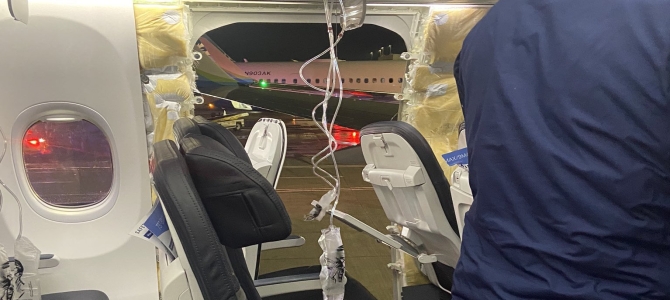
A passenger plane lost a section of its fuselage in mid-air, forcing it to make an emergency landing in the US state of Oregon on Friday.
The Alaska Airlines Boeing 737 Max 9 returned to Portland 35 minutes into its flight to California after an outer section, including a window, fell.
Alaska said 177 passengers and crew were on board and it "landed safely".
The airline said it would "temporarily" ground all 65 of its 737 Max 9 aircraft to conduct inspections.
Boeing said it was aware of the incident and is "working to gather more information".
The UK Civil Aviation Authority told the BBC it is "monitoring the situation very closely".
Passenger Diego Murillo, who had been on his way to Ontario, California, said the gap was "as wide as a refrigerator" and described hearing a "really loud bang" as the oxygen masks dropped from above.
He told KPTV: "They said there was a kid in that row whose shirt was sucked off him and out of the plane and his mother was holding onto him to make sure he didn't go with it."
Announcing the grounding of the 65 planes, Alaska Airlines' CEO Ben Minicucci said: "Each aircraft will be returned to service only after completion of full maintenance and safety inspections."
Mr Minicucci praised the efforts of the six crew members on board the flight which had reached 16,000ft (4,876m) when it began its emergency descent, according to flight tracking data.
Images sent to news outlets show the night sky visible through the gap in the aircraft's fuselage, with insulation material and other debris also seen.
Other pictures show the seat closest to the affected section, a window seat that passengers said was unoccupied, leaning forward without its cushion.
"My heart goes out to those who were on this flight - I am so sorry for what you experienced," Mr Minicucci said.
"I am so grateful for the response of our pilots and flight attendants."
In an audio clip, the pilot can be heard talking to air traffic control requesting a diversion.
"We'd like to get lower if possible," she asked. "We are an emergency. We are depressurised, we do need to return back. We have 177 passengers."
According to photographs, the affected area was in the back third of the plane, behind the wing and engines.
The section of fuselage involved appears to be an area that can be used as an additional emergency exit door by some operators of the aircraft type, but not by Alaska.
The US Federal Aviation Agency (FAA) confirmed Alaska Airlines Flight 1282 "returned safely... after the crew reported a pressurisation issue".
Boeing said a "technical team stands ready to support the investigation".
The National Transportation Safety Board (NTSB) confirmed it is investigating the incident.
The Boeing 737 Max has been described as "the most scrutinised transport aircraft in history" after a series of safety issues and investigations.
The Max was grounded in March 2019 for a year-and-a-half after two of the type crashed in similar circumstances, killing those on board.
Aviation expert John Strickland said the Alaska Airlines incident is very different to those crashes, adding since the 737 Max came back into service it had "an enormous safety record".
"While we know little evidence of why this section of the fuselage has come out - this has nothing to do with the aircraft being grounded for 18 months," he told BBC News.
"But, it is natural Alaska Airlines is taking a cautious approach grounding its fleet and we will have to see what happens in the coming hours if any more directives are issued by Boeing and the American authorities."
More recently, Boeing said it would increase the pace of 737 Max deliveries after resolving a supply error that required it to conduct lengthy inspections of new planes and its inventory, Reuters news agency reported.
About 1,300 737 Max aircraft have been delivered to customers, Boeing data shows.
Last month, the Federal Aviation Administration (FAA) urged airlines to inspect Max models for a possible loose bolt in rudder control systems.
BBC NEWS
Rośnie presja na Pałac Kensington, by opublikować oryginalne zdjęcia księżnej Kate, a nie takie, które zostały zmanipulowane cyfrowo. Manipulacji, jak się...
London Eye forced to close after being battered by 70mph Storm Henk winds. A family were left terrified as the London Eye was battered by strong winds on Tuesday (January 2).
Setki osób zebrały się w sobotę przed siedzibą BBC w Londynie, protestując przeciw — jak twierdzą — stronniczości publicznej stacji w relacjonowaniu...
Policja wszczęła obławę na podejrzanego o terroryzm Daniela Abeda Khalife’a, który uciekł z więzienia w Wandsworth, podaje BBC. Mężczyzna zbiegł,...
Grecja będzie chciała zadośćuczynić turystom, których wakacje zostały zepsute w związku z pożarami na Rodos. Poszkodowane osoby w przyszłym roku będą mogły...